Sweetness and Lightning (Amaama to Inazuma) Anime Review
When it came to what anime I would watch for the Summer 2016 cour, Sweetness and Lightning (or as it is known in Japan, Amaama to Inazuma) was not on my list. However, after seeing several cute and adorable images get posted online, combined with a very positive response to the series, I had to check it out for myself. I’m glad I did.
The Plot ***SPOILERS***
For those who haven’t watched the series, Sweetness and Lightning is the story of INUZUKA Kouhei, a high school teacher and recent widower, and his daughter Tsumugi, who’s in kindergarten. The two attend a hanami to see the sakura in bloom and encounter what turns out to be a female student of Kouhei’s, IIDA Kotori. Kouhei, who can’t cook, accepts an invitation from Kotori to visit her mother’s restaurant, Megumi. However, when he arrives with Tsumugi, Kotori’s mother (also named Megumi) isn’t there, but Kotori manages to make some rice.
Thus starts a friendship between Kotori, Kouhei, and Tsumugi. Kouhei and Tsumugi end up coming over to Megumi Restaurant regularly where Kouhei and Kotori prepare new meals. The two have covert discussions about things at school. Also entering the mix are Kouhei’s best friend Yagi, whom Kotori initially mistakes as a kidnapper, and Kotori’s friend Shinobu. Both Yagi and Shinobu end up joining Kotori, Kouhei, and Tsumugi on some of their cooking adventures.
Tsumugi
The biggest draw to the anime is going to be the ultra adorable Tsumugi. Rather than hire an adult seiyuu to voice this young girl, TMS wisely hires an actual young girl to provide the voice. I know there are instances where adult seiyuu are fine for the roll of young girls. Cardcaptor Sakura springs to mind. (At least, I didn’t have any problem with them.) However, for Sweetness and Lightning, the actual innocence of youth comes through perfectly for Tsumugi because she is voiced by a child (ENDOU Rina).
See what I mean with this video clip.
Tsumugi is mostly cute and adorable, but the series doesn’t forget that she is a kid. As such, they give her kid foibles, such as turning up her nose at green peppers, acting spoiled at times, getting sick, getting depressed, or getting angry with her dad over something. For me, this added element to Tsumugi’s character gives her a realistic foundation. I liked that.
While Tsumugi may be the central focus of a story at times, such as seen in the above video clip, most of the time she is a kind of McGuffin for the series. The only reason her dad learns to cook is because of Tsumugi. That desire to make Tsumugi happy is often the driving factor behind most of the episodes. Without that, Kouhei wouldn’t have done any of the things that he ultimately did.
Still, there’s no denying that Tsumugi is the sugary sweet element to this anime, thanks to how adorable she is.
Kouhei and Kotori
While Tsumugi may be the face that gets the big draw, the other half of the equation has Tsumugi’s father Kouhei and his student Kotori. The friendship they form is quite sweet and wholesome, even if it is a bit unusual. While the anime mostly suppresses any notion of romance between student and teacher, a tiny residue remains from the manga stories the anime adapted. (Not that there’s a heavy romance in the manga, but it is actually addressed.)
For Kotori, Kouhei fills the roll of a mentor and even a father figure to a degree (though I don’t think Kouhei is more than ten years older than Kotori). The series doesn’t discuss her parents much, but we do learn that Kotori’s dad divorced her mom. Kotori’s mom is a celebrity chef, so she’s never around due to work. At school, Kotori only has one friend her age, Shinobu. Shinobu is often busy after school, so I can understand why Kotori would reach out to Kouhei and Tsumugi. They fill the void in her life.
For Kouhei, there’s clearly some loneliness on his part. Yes, he has Tsumugi, but since Kotori has a maturity well above her teenage years, Kouhei finds himself confiding in Kotori as a friend. There’s no doubt that Kouhei enjoys his time with Kotori. Since Tsumugi loves Kotori, that makes things even better for Kouhei. Kouhei hasn’t discovered the hole in his own heart that Kotori is filling after his wife died.
Cooking is King
While Sweetness and Lightning is a slice of life anime series, it is also a cooking anime. Good grief, even if I made sure I ate before watching an episode, by the time the episode ended, I was often quite hungry. I’m glad that most of the time, the Japanese names for the dishes are used. That way, I know what to look for in Japanese restaurants I go to.
That said, for a series with so much focus on cooking, one would think that it would be a boring anime. For me, the mixture of Tsumugi’s adorableness, Kotori’s cuteness, and Kouhei’s earnestness overcome any possibility of boredom from watching folks cook.
There’s also the slice of life stories, to which cooking becomes the response. Let’s face it, many of us use food to celebrate. Many of us turn to food during times of sadness. Food is an important part of our life because we need it to live. So for Kotori and Kouhei to make meals in response to events, or simply to make good meals for Tsumugi, it makes sense that cooking would be king for this anime series.
Final Thoughts and Conclusion
For the most part, Crunchyroll’s adaptation was fine. Full Japanese honorifics are used, which is always a plus for me. There were occasions where weird choices were made for the adaptation. For example, any sushi restaurant I’ve gone too has “tamago sushi” on the menu. They sometimes have an explanation of what that is. They never call it “egg sushi,” which Crunchyroll did in one episode.
Weird.
In the end, Sweetness and Lighting is a highly enjoyable, wholesome, delightful, and adorable slice of life anime cooking series. I’m very glad I decided to watch this, and the advertisement aspect of the anime caused me to buy the manga. I’ll review that down the road.



 September 30th, 2016
September 30th, 2016  AstroNerdBoy
AstroNerdBoy 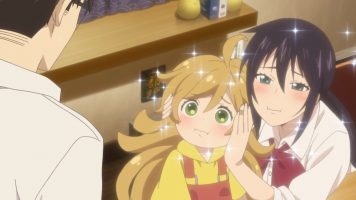
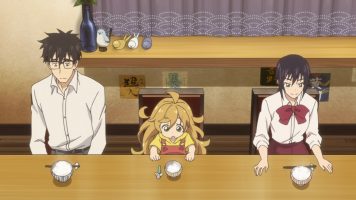
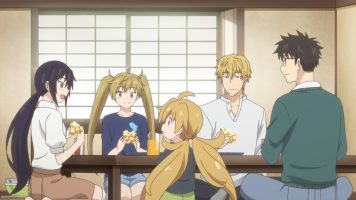





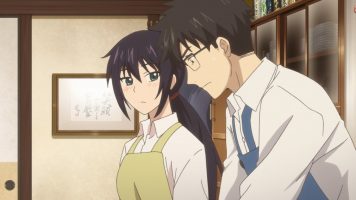


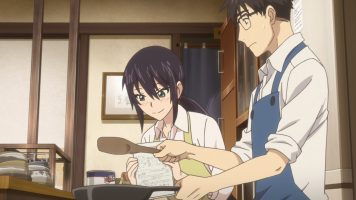


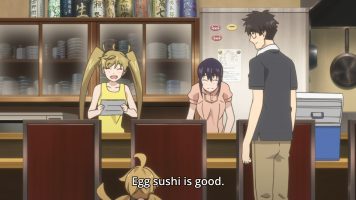
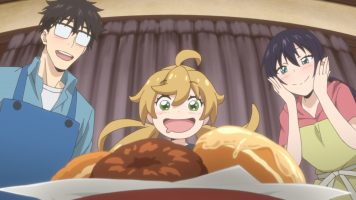
 Posted in
Posted in  Tags:
Tags: 
I like Kotori. Her awareness of Kouhei’s loss and grief, and her own loneliness, with her attempts to help, resonate in all the scenes. That initial encounter when she’s sitting on the ground cloth at the sakura viewing, crying, as Kouhei and Tsumugii happen along, sets the theme. She says, “It’s not because I’m lonely . . .” but of course she is. She’s just eaten all the food that her mother had prepared for them both because her mother has bailed out of their meeting. I love her attempts at nonchalance in the face of her sadness.
Yeah, I like Kotori as well. I’m looking forward to reading more in the manga.
I honestly thought there would be a big reveal that Kouhei’s mother was dead, until she appeared on TV around episode 3.
Thanks for the the video clip with Tsumugi and the sharks. I loved it. One place where anime can exceed the manga!
Very true! 🙂
Anime doesn’t always exceed manga in action scenes! I’m rereading the manga “Gundam the Origin,” in which Mr. Yazuhiko manufactures the best art in manga. His action scenes are so good that the reader can easily create his own “in betweens” that flash one’s consciousness as well as in anime! Mr. Yazuhiko had been a production artist on the first “Gundam” anime 25+ years ago. He voluntarily retired from that work, but answered the call for an artist for “The Origin.” Vertical Publishing got the best. His from-scratch panels look like stills from a movie, so the reader’s pattern recognition can fill in the blanks in a way that allows us to roam in time around the action. Way cool. Manga can compete with anime during action scenes, especially with a genius like Yazuhiko-sensei behind the brush.
The The Origin OVA series has been pretty good.
What a lovely review, thanks. I’m also a fan of this anime! I will never forget the scene when tsumugi did her best when his father was sick! I’m so touch in that episode. Thanks!
You’re welcome. I need to read volume 3, 4, and I think 5.